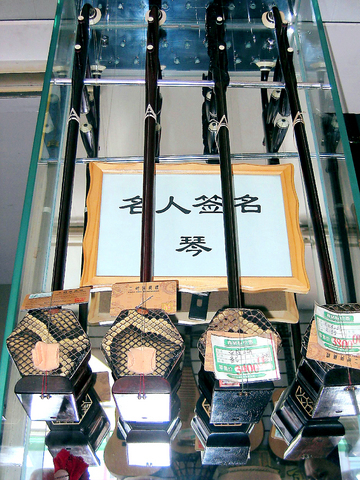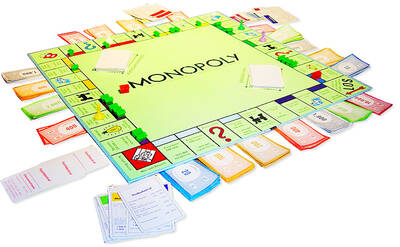he sad and sonorous sound of the erhu, the musical instrument that epitomizes Chinese music, is weathering an attack from nature lovers who fear its snake skin covered sound box is driving the mighty python into extinction.
Favorably compared to the violin, the erhu is revered in China for its natural sound and has long been viewed as the instrument that best reflects the human voice, most notably a weeping lady.
Countless pieces of music, mostly sad and melancholy, have been written for the long-necked two-stringed instrument, played with a horsehair bow and boasting a more than 1,000 year history.

PHOTO: AFP
"The most important part of the erhu is the python skin, the reverberations of the skin give the erhu its unique sound," said Yang Youlin, manager of the Beijing Music Book Store.
"Without the python skin, an erhu is not an erhu. Snake skin, sheep skin, wood, won't do."
Even the cost of an erhu, which range up to 8,000 yuan (US$1,000), depends on what part of the python is used for the sound box membrane, with seasoned erhu players preferring the belly side of the snake near the tail, Yang said.

PHOTO: AFP
"A lot of factors go into the sound -- the age of the snake, the size and the uniformity of the scales and the thickness of the skin are all important," Yang said.
The problem is that with China's economy booming, more and more people are buying and learning to play the instrument.
China's opening up to the West has also ensured that an increasing number of overseas fans, especially in Japan and Singapore, are also buying the instrument.
Other instruments, like the sanxian, a three stringed plucked instrument, also uses a python skinned sound box, while python skins have long been used for Chinese drums and tambourines.
The nation's growing demand for python is further stepping up competition internationally where python skins are valued in the usual reptilian fare of purses, wallets, jackets, boots, belts and bags.
"The python has been nearly extinct in China in the wild since the 1980s and much of this is because of the demand for python skins in the music industry," said Xu Hongfa, a wildlife trade expert for TRAFFIC East Asia, a group that monitors the trafficking in endangered species.
"Since then, the wild populations in Southeast Asia have begun to fall and the smuggling of python skins from Southeast Asia into China has grown."
A relish for python meat in southern China, he said, has also played a role in the demise of the snake that thrives in a jungle setting and can grow to up to 6m long.
After ratifying the UN Convention on the International Trade in Endangered Species (CITES), China passed its Law on the Protection of Endangered Species in 1988, effectively making the unlicensed use and trade in pythons illegal, Xu said.
But implementation of the law has not been easy, prompting TRAFFIC East Asia and other environmental groups to work with the State Forestry Administration to set up a certification process between python skin sellers in Southeast Asia and musical instrument factories in China.
New regulations that went into effect on Jan. 1 also require that all erhus have a certificate from the administration, which certify that the erhu python skin is not made with wild pythons, but from farm-raised pythons, he said.
Individuals are now only allowed to take two erhus out of China when travelling, while commercial buyers also need additional export certificates.
"The situation was getting out of hand, so the government had to do something," said Feng Yuankai, spokesman for the China Musical Instrument Association.
"Basically the manufacturers have supported and embraced the new policy as a way to maintain a sustainable industry, the certification also means that they are legally trading in python skins, which was not the case before the new regulations."
In 2003, China's nearly 100 erhu manufacturing enterprises used some 30,000 python skins to produce about 400,000 erhus, with production expected to continue rising with growing international demand, Feng said.
"This is a 1,000-year-old tradition in China, so at first I think that the manufacturers were not too happy about the new policy," said TRAFFIC East Asia's Hu.
"The new regulations have resulted in the price of python skin rising by almost 100 percent, but now the manufacturers are finding that they can raise the price of their erhu as well, which I think they like."

With one week left until election day, the drama is high in the race for the Chinese Nationalist Party (KMT) chair. The race is still potentially wide open between the three frontrunners. The most accurate poll is done by Apollo Survey & Research Co (艾普羅民調公司), which was conducted a week and a half ago with two-thirds of the respondents party members, who are the only ones eligible to vote. For details on the candidates, check the Oct. 4 edition of this column, “A look at the KMT chair candidates” on page 12. The popular frontrunner was 56-year-old Cheng Li-wun (鄭麗文)

“How China Threatens to Force Taiwan Into a Total Blackout” screamed a Wall Street Journal (WSJ) headline last week, yet another of the endless clickbait examples of the energy threat via blockade that doesn’t exist. Since the headline is recycled, I will recycle the rebuttal: once industrial power demand collapses (there’s a blockade so trade is gone, remember?) “a handful of shops and factories could run for months on coal and renewables, as Ko Yun-ling (柯昀伶) and Chao Chia-wei (趙家緯) pointed out in a piece at Taiwan Insight earlier this year.” Sadly, the existence of these facts will not stop the

Oct. 13 to Oct. 19 When ordered to resign from her teaching position in June 1928 due to her husband’s anti-colonial activities, Lin Shih-hao (林氏好) refused to back down. The next day, she still showed up at Tainan Second Preschool, where she was warned that she would be fired if she didn’t comply. Lin continued to ignore the orders and was eventually let go without severance — even losing her pay for that month. Rather than despairing, she found a non-government job and even joined her husband Lu Ping-ting’s (盧丙丁) non-violent resistance and labor rights movements. When the government’s 1931 crackdown

The first Monopoly set I ever owned was the one everyone had — the classic edition with Mr Monopoly on the box. I bought it as a souvenir on holiday in my 30s. Twenty-five years later, I’ve got thousands of boxes stacked away in a warehouse, four Guinness World Records and have made several TV appearances. When Guinness visited my warehouse last year, they spent a whole day counting my collection. By the end, they confirmed I had 4,379 different sets. That was the fourth time I’d broken the record. There are many variants of Monopoly, and countries and businesses are constantly